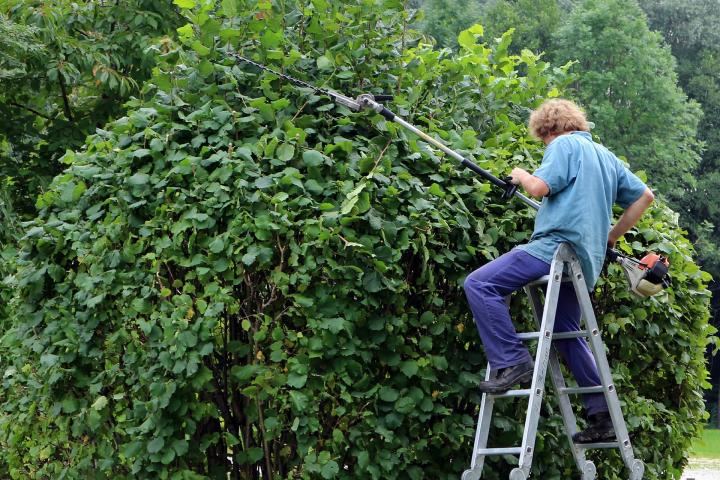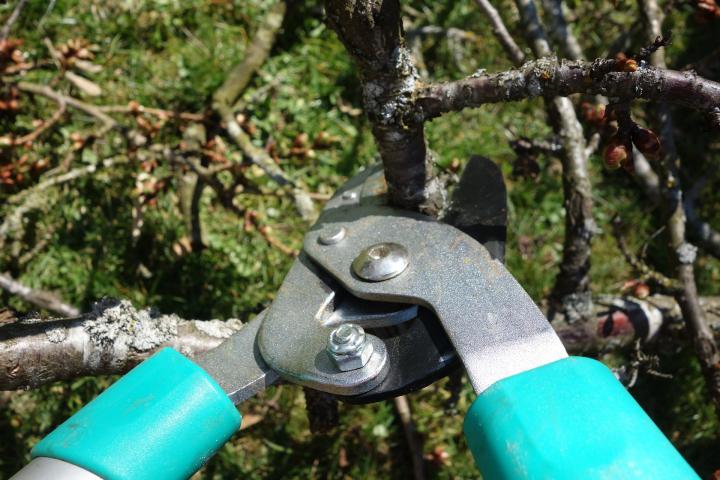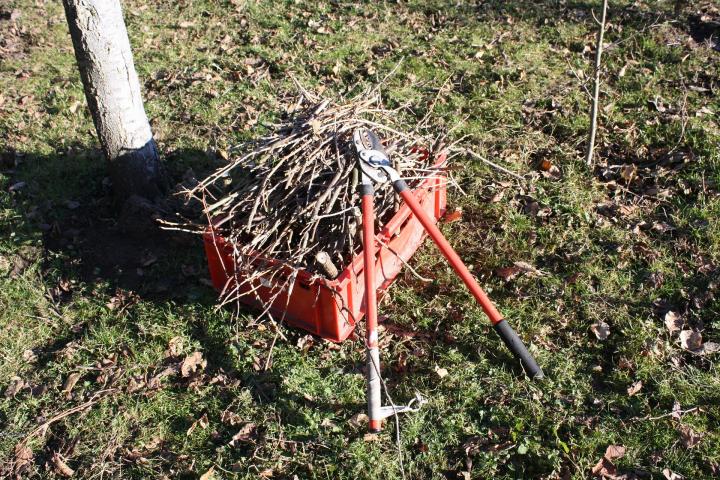When should you prune shrubs and trees? It depends! 1) Spring-flowering plants are pruned right after they flower in the spring. 2) Summer-flowering plants are pruned in cold months while dormant. Prune at the wrong time and you won’t have flowers! See our plant lists and learn more.
Why Prune Shrubs and Trees?
Most shrubs and trees do not have to be pruned, but they can benefit from pruning to improve their shape and structure. Remember that pruning isn’t bad for trees; it strengthens the plant with less risk of disease and pests. A good haircut can make a tree look better, too!
- Plant health is the primary reason for pruning. Look for the 4 “Ds”—dead, dying, diseased, or damaged branches—these should be removed. Also, look for spindly or weak growth, as well as any branches that are crossed or rubbing.
- Safety is another critical issue. Low-hanging branches can be eye-pokers and get in the way when trying to work or play around a shade tree. Pruning these branches is called limbing up. Not only does it encourage top growth, but it also makes room for you to enjoy the area under the tree safely. If your trees have weak, dangling branches that could break off unexpectedly, they harm people, cars, buildings, and valuable plants underneath. It is best to call a professional tree trimming company if these branches are high up, very large, or near power lines.
- Pruning can make plants hardier and help them overwinter, too.
- Often, a plant needs pruning to control its size. Overgrown shrubs can be brought back to scale, large shade trees can be reduced enough to cast less shadow, and fruit trees can be kept to a reasonable size, making care and harvesting easier. Hedges can be maintained at the desired size and shape. Water sprouts (small, spindly branches) that grow straight up from the limbs of a fruit tree will not bear fruit and should be clipped off as they develop.
- For some plants, pruning encourages flowers and makes room for new growth. Of course, the bloom time is critical to know WHEN to prune. The best time to prune a flowering tree, shrub, or vine is after it finishes blooming so you don’t cut off its flowers for the season!

When to Prune Trees and Shrubs
When to prune trees and shrubs is a hot topic, and there’s no question that spring is the ideal time to inspect your trees and shrubs for winter damage. It is much easier to see the structure of deciduous plants without their leaves, so pruning can be accomplished quickly and easily. Most trees are still dormant and will bleed less sap, and insects and diseases are less active.
The correct time to perform this pruning depends on when the plant blooms.
Prune Spring-Flowering Trees and Shrubs After Bloom
Prune spring-flowering shrubs and trees right after they bloom in the spring. Do NOT prune in fall or winter.
These plants develop their buds on old wood—branches that grew last year. By fall, they’ve already formed flower buds; if you cut off them, you won’t get any spring blooms. Pruning after they bloom gives new growth plenty of time to ripen before winter and bear maximum flowers next spring.
Shrubs that are spring bloomers include:
- Forsythia
- Lilac
- Star magnolia
- Mock orange
- Azalea
- Camellias
- Oakleaf hydrangea and mophead-type hydrangeas (Hydrangea macrophylla)
- Rhododendron
- Mountain laurel
- Loropetalum
- Dogwood
- Flowering cherry, peach, plum, pear, crabapple
- Quince
- Andromeda
- Spirea
- Viburnum
- Maples, birches, dogwoods, walnuts, and elm trees (wait until summer)
If you wait until after they bloom, you can deadhead and prune simultaneously. This will encourage new growth and give you more flowers next year.
Mature shrubs should be pruned hard, cutting back most flowering stems to a healthy new shoot and taking the oldest growth (but no more than 1/3 of the oldest stems) back to the base yearly so it is completely renewed every few years. A very overgrown shrub should be renewed in this gradual manner, too. Young shrubs should have the weakest growth cut back, with the remainder pruned to shape and size. Weed, water, and mulch with compost after pruning is done.

Prune Summer-Flowering Plants in Winter
Prune summer-flowering woody plants while dormant in late winter (or early spring) to encourage more new wood to form. Pruning in the fall stimulates new growth when the plants try to go dormant; this weakens plants. These plants form flower buds on new growth next season, not last year’s old growth.
Pruning summer-blooming shrubs in late winter can encourage new growth and flowers for the coming season.
- Beauty berries
- Hydrangea paniculata (‘Annabelle’, ‘Limelight’, and peegee type hydrangea)
- Rose of Sharon, Hibiscus
- Gardenia
- Clethra
- Buddleja set their buds on new wood.
- Angel’s trumpet
- Crepe myrtle
- Roses
- Abelia
- Fruit trees: crabapples, cherries, plums
- Poplar, spruce, junipers, sumacs (prune in late winter)

Note that when you prune hydrangea depends on the variety. See how to prune hydrangea varieties.
Non-Flowering Trees and Shrubs
- Late winter during dormancy is also the right time to prune any nonflowering trees and shrubs, as well as conifers.
- However, you can lightly shape hedges and conifers any time of the year. In addition, it’s okay to trim back small twigs and branches any time of year.
- Of course, always remove dead or diseased branches as soon as you’re able to do so. Don’t leave a tree weakened by dead and dying branches.
5 Tips on How to Prune
The art of pruning is a skill that you can develop over time. Don’t be afraid to experiment and learn as you go, and don’t hesitate to consult a good book on the subject or check with your county extension office for information on pruning specific plants. Knowing your plant and its purpose, especially when it blooms, you can prune it correctly.
Be careful not to over-prune. As stated, pruning isn’t critical but benefits the plant’s health and better bloom (and for wildlife). Keep in mind that not all shrubs need to be pruned regularly. For example, shrubs with a naturally compact habit only need pruning to remove an occasional stray shoot or broken branch.
- When pruning shrubs, first remove any dead or dying branches. Cut between the diseased spot and the body of the plant. Then remove the oldest, tallest growth and weak or spindly stems first. Prune branches that rub or cross each other or are growing vertically (cutting the smaller branch). You can also take off low branches.
- Prune back to the main stem, cutting the branch close to the source. Don’t let stubs stick out; this invites disease.
- Cut at the same angle as the branch collar—the furrow of bark where branch and trunk meet. If you’ve done it right, a circle of healthy callus will eventually swell around the spot.
- Never prune if it’s damp out; this spreads many diseases. Wait for a dry day.
- Always clean your tools with hot, soapy water to avoid spreading disease. If you cut off a diseased branch, clean it before moving on to the next tree. You can also disinfect the tools by using just a teaspoon or two of bleach in warm water.
To learn more about how to prune, see our Pruning Pointers for Trees and Shrubs and the Spring Pruning Guide for Trees and Shrubs.












